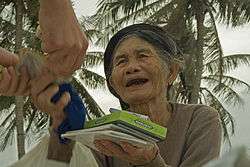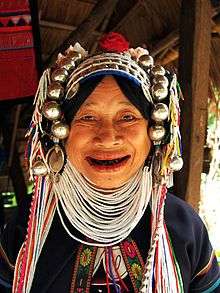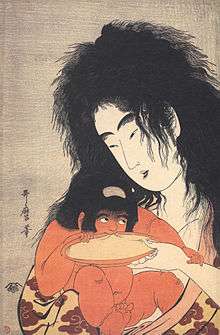Teeth blackening
Teeth blackening or teeth lacquering is a custom of dyeing one's teeth black. It was most predominantly practiced in Southeast Asian and Oceanic cultures, particularly among Austronesian, Austroasiatic, and Kra-Dai-speaking peoples. It was also practiced in Japan prior to the Meiji era, as well as in India.[1][2] It was also performed among some groups in the Americas, most notably among the Shuar people of northern Peru and Ecuador.[3]
Teeth blackening is usually done during puberty. It was primarily done to preserve the teeth into old age, as it prevents tooth decay similar to the mechanism of modern dental sealants. It was seen as a sign of maturity, beauty, and of civilization. A common belief is that blackened teeth differentiated humans from animals. Teeth blackening is often done in conjunction with traditions of teeth filing and evulsion, as well as other body modification customs like tattoos. Teeth blackening and filing were regarded with fascination and disapproval by early European explorers and colonists. The practice survives in some isolated ethnic groups in Southeast Asia and Oceania but has mostly disappeared after the introduction of Western beauty standards during the colonial era.[1][2][3]
Teeth blackening is commonly confused with the red-stained teeth from betel chewing. However, betel chewing damages the teeth and gums while teeth blackening does not.[1][2]
By country
Japan

In Japan, teeth blackening is known as Ohaguro (お歯黒). Ohaguro existed in one form or another for hundreds of years and was seen amongst the population as beautiful until the end of the Meiji period. Objects that were pitch black, such as glaze-like lacquer, were seen as beautiful.
Name
The word "ohaguro" was a Japanese aristocratic term. There is an alternate reading for ohaguro, 鉄漿 kane (literally 'iron drink'). At the old Imperial palace in Kyoto, it was called fushimizu (五倍子水). Among the civilians, such words as kanetsuke (鉄漿付け), tsukegane (つけがね) and hagurome (歯黒め) were used.
History
- Traces of blackened teeth can be seen in the buried bones and haniwa (250 to 538 CE) from the Kofun period.
- Shōsōin, a treasure house connected to Tōdai-ji in Nara, holds the teachings brought to Japan by Jianzhen in 753.
References to ohaguro exist in The Tale of Genji[4] and Tsutsumi Chūnagon Monogatari. At the end of the Heian period, at the time when aristocratic men and woman reached puberty and celebrated their genpuku or mogi, the Taira clan and other samurai, and pages working at large temples, dyed their teeth. In particular, the imperial family and other high-ranking aristocrats who had finished their hakamaza (ceremony where a child is fitted with a hakama) blackened their teeth and painted their eyebrows (hikimayu (引眉)). This was done in the imperial household until the end of the Edo era.
In the Muromachi period, ohaguro was generally seen among adults, though when the Sengoku period arrived, so as to prepare for political marriages of convenience, when the daughters of military commanders were around 8 to 10 years old, they would blacken their teeth as a marking of their coming of age. Relatives and guardians of the bride who blackened their teeth were called kaneoya (鉄漿親). It is said that military commanders who were struck in the head on the battlefield and who did not want to be ugly would wear average women's makeup and would blacken their teeth. These faces imitated the Noh masks of women and young boys.
After the Edo period, only men of the Imperial House of Japan and the aristocracy blackened their teeth. Due to the odor and labor required for the process, as well as a feeling among young women that they were aging, ohaguro was done only by married women, unmarried women who were older than 18, sex workers and geisha. For rural people, ohaguro was done only at times of special celebrations, such as Japanese festivals, wedding ceremonies, and funerals. There were also depictions of ohaguro in fairy tales, such as "Gon, the Little Fox".
On February 5, 1870, the government banned ohaguro and the process gradually became obsolete. After the Meiji period, it temporarily spread, but it almost entirely died out in the Taishō period (ending in 1927).
In contemporary times, the only places where ohaguro can be seen is in plays, hanamachi (geisha districts), some festivals, and movies.
Social function
Many Westerners, including Engelbert Kaempfer, Philipp Franz von Siebold, and Rutherford Alcock, who visited Edo-era Japan, described ohaguro as an abhorrent custom which disfigured women.[5] Alcock conjectured that the purpose of it is chastity by making the women intentionally unattractive to prevent extramarital relationships. Japanese social scientist Kyouji Watanabe disagrees with this theory. Based on the fact that Japanese girls were allowed a large degree of both social and sexual liberty until the time of Ohaguro, when they assumed the responsibility of wife and mother, Watanabe thinks that it was a social ritual by which both society and girls confirmed the determination of matured women.[6]
Dyes
The main ingredient was a dark-brown solution of ferric acetate called kanemizu (かねみず), made by dissolving iron filings in vinegar. When the solution was combined with vegetable tannins from such sources as gallnut powder or tea powder, it would turn black and become non-water-soluble, in the same manner that iron gall ink is produced. Coating the teeth with this liquid helped to prevent tooth decay and enamel decay. The dye had to be applied once a day or once every few days.
As a convenient prescription, a fine powder of gallnut powder, sulfuric acid, and oyster shell could also be applied to the teeth, though this never really caught on.
In theatrical plays, ink mixed with turpentine was used, though these days, ink mixed with tooth wax is used.
Superstitions and urban legends
- In the Meiji period, a rumor spread about an area where a virgin's blood was painted on an electric line. As a result of not wanting to have their blood taken as well, many of the young women in this area changed their appearances to match those of married women by blackening their teeth, painting their eyebrows and wearing simple kimono.
- In Yamada Norio's 2010 book "A Trip of Tōhoku Ghost Stories" (山田野理夫東北怪談全集), a story about Fukushima Prefecture is described (お歯黒べったり, "Ohaguro Bettari").
Elsewhere

The practice of blackening teeth continues among many minority groups in China, Pacific Islands and Southeast Asia. It is mainly prevalent in older women, though the practice is still carried on by some younger women. Sometimes artificial teeth are used to achieve blackened teeth.
In Vietnam, tooth painting was practiced by the majority Vietnamese people as well as by minority ethnic groups. Si La men paint their teeth red and the women paint theirs black. This practice has slowly declined with each new generation. When Han Chinese ruled the Vietnamese in the Fourth Chinese domination of Vietnam due to the Ming dynasty's conquest during the Ming–Hồ War they imposed the Han Chinese style of men wearing long hair on short haired Vietnamese men. Vietnamese were ordered to stop cutting and instead grow their hair long and switch to Han Chinese clothing in only a month by a Ming official. Ming administrators said their mission was to civilize the unorthodox Vietnamese barbarians.[7] The Ming dynasty only wanted the Vietnamese to wear long hair and to stop teeth blackening so they could have white teeth and long hair like Chinese.[8] A royal edict was issued by Vietnam in 1474 forbidding Vietnamese from adopting foreign languages, hairstyles and clothes like that of the Lao, Champa or the "Northerners" which referred to the Ming. The edict was recorded in the 1479 Complete Chronicle of Dai Viet of Ngô Sĩ Liên.[9]
In the Philippines, Spanish colonial official and historian, Antonio de Morga, recorded in his book, Sucesos de las Islas Filipinas (1609), on how local men and women of the Philippines cared and presented themselves at the time. It was noted by Morga: "All are very careful of their teeth, which from a very early age they file and render even, with stones and iron. They dye them a black color, which is lasting, and which preserves their teeth until they are very old, although it is ugly to look at." The late 19th century Filipino nationalist, writer, and polymath, José Rizal, commented in his annotations to Morga's account that: "This custom still exists... This custom exists also among the married women of Japan, as a Sign of their chastity. It is now falling into disuse."
- Yunnan, China
- Blang people
- Dai
- Hmoob
- Jino
- người Kinh (Vietnamese people in China)
- Lahu
- Yao
- Laos
- Philippines
- Pacific Islands [10]
- Thailand
- Vietnam
- India
The agent of choice for teeth blackening became known as missī, a powdery mixture of (1) iron and copper sulphate, (2) a plant source of tannins, such as myrobalans, and (3) flavouring agents. The use of missī, thought to be sanctified by Fāṭimah, the Prophet's daughter, became deeply engrained in Islamic culture across much of the subcontinent. Teeth blackening as a life cycle event related to sexual maturity and in its literary portrayals acquired distinct sexual overtones. It was integrated into to the culture of courtesans and prostitutes where missī became synonymous with the ritual of selling a woman’s virginity. Although not a primary motivation, medicinal considerations also played a role in the use of missī. Early references to blackening the gums and edges of the teeth suggest a connection to an older tradition of filing the interstices between teeth which had become prohibited by Islamic law. Geographically and culturally distinct traditions of teeth blackening also prevailed among diverse indigenous groups living along the slopes of the Eastern Himalayas, from Nepal through Meghalaya and Assam to Nagaland. Here teeth were blackened by applying the wood tar of specific plants or chewing specific plant products. These practices related technologically and culturally to the wide-spread teeth blackening traditions of island and mainland South-east Asia and beyond.[11]
Further west, teeth blackening has been documented as far as Madagascar.[12]
References
- Zumbroich, Thomas J. (2009). "'Teeth as black as a bumble bee's wings': The ethnobotany of teeth blackening in Southeast Asia". Ethnobotany Research & Applications. 7: 381–398. doi:10.17348/era.7.0.381-398.
- Zumbroich, Thomas (2015). " We Blacken Our Teeth with Oko to Make Them Firm:Teeth Blackening in Oceania". Anthropologica. 57: 539–555.
- Pinchi, Vilma; Barbieri, Patrizia; Pradella, Francesco; Focardi, Martina; Bartolini, Viola; Norelli, Gian-Aristide (15 March 2015). "Dental Ritual Mutilations and Forensic Odontologist Practice: a Review of the Literature". Acta Stomatologica Croatica. 49 (1): 3–13. doi:10.15644/asc49/1/1. PMC 4945341. PMID 27688380.
- Murasaki Shikibu, The Tale of Genji, translated by Royall Tyler. Chapter 6, page 130. Penguin Classics. Reprint 2003. First published 2001. ISBN 0-14-243714-X - see also note 57 by Royall Tyler
- Kyouji Watanabe, "Yukishi Yono Omokage", Kindle location 5778, ISBN 4582765521, Published by Heibonsha.
- Kyouji Watanabe, "Yukishi Yono Omokage", Kindle location 5778, ISBN 4582765521, Published by Heibonsha.
- The Vietnam Review: VR., Volume 3. Vietnam Review. 1997. p. 35.
- Baldanza, Kathlene (2016). Ming China and Vietnam: Negotiating Borders in Early Modern Asia. Cambridge University Press. p. 110. ISBN 1316531317.
- Dutton, George; Werner, Jayne; Whitmore, John K., eds. (2012). Sources of Vietnamese Tradition. Introduction to Asian Civilizations (illustrated ed.). Columbia University Press. p. 87. ISBN 0231511108.
- Sheila Benavente. "Mariana's Past". Offisland.com. Retrieved 2012-12-21.
- Zumbroich, Thomas J. (2015). "The missī-stained finger-tip of the fair': A cultural history of teeth and gum blackening in South Asia". eJournal of Indian Medicine. 8 (1): 1.
- "Zumbroich, Thomas J. 2012. 'Ny vazana tsy aseho vahiny' - 'Don't show your molars to strangers' - Expressions of teeth blackening in Madagascar. Ethnobotany Research & Applications 10:523-539". Retrieved 2015-02-25.

